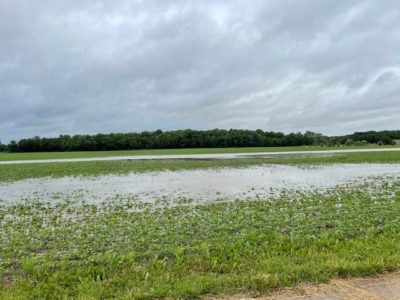 We are enjoying a break from work now that the crops are planted and we’ve done what we can to provide an environment for them to grow well. We have reached the “wait and see” stage of crop production. We are watching Mother Nature do her work, and we will see how the crops perform.
We are enjoying a break from work now that the crops are planted and we’ve done what we can to provide an environment for them to grow well. We have reached the “wait and see” stage of crop production. We are watching Mother Nature do her work, and we will see how the crops perform.
As we watch what is happening in our fields, we are seeing indications of the value of the sustainable practices we use.
On June 20, a storm dropped more than 8 cm, or 3.2 inches, of rain in our area. That is a lot of water for the fields to manage, but we could see visible differences in the rate of water absorption in our fields where we use cover crops and a form of conservation tillage. Those fields had less standing water after that heavy rain as the good soil structure we’ve promoted held water well. We just saw surface ponding in spots at the end of our fields where we turn equipment around, causing more soil compaction. We also can see how our filter strips pull and hold water, sediment and nutrients following these storms.
 In the days following heavy rains like that one, we can see how ground around our tiles dries more quickly. At the same time, our water control structures are slowing the flow of that water into our local ditches and streams that carry it away from our farm. They also hold some of that draining water to make it available should we get another dry period. Holding back the water allows more nutrients to be absorbed by plants and protects the local water system from a large influx of runoff. Preliminary data from the water quality study we are participating in is showing that even following storms like this, we are keeping more of the nutrients we applied on our farm so they are available for our crops as needed.
In the days following heavy rains like that one, we can see how ground around our tiles dries more quickly. At the same time, our water control structures are slowing the flow of that water into our local ditches and streams that carry it away from our farm. They also hold some of that draining water to make it available should we get another dry period. Holding back the water allows more nutrients to be absorbed by plants and protects the local water system from a large influx of runoff. Preliminary data from the water quality study we are participating in is showing that even following storms like this, we are keeping more of the nutrients we applied on our farm so they are available for our crops as needed.
It is very encouraging to see that our efforts to manage water quality are making a difference in our fields. We know that soybeans don’t like “wet feet,” meaning they don’t grow well in standing water that saturates their roots. Our practices help prevent these conditions, helping our soybeans handle heavy rains.
About 8 hours after a major storm, we could see visible differences between how our fields (above) managed the water compared to neighboring fields using different practices (below). These photos are of fields next to each other, taken at the same time.
Our soybeans have been growing a bit more slowly than expected, but they have nearly reached canopy, when the plants have grown big enough that their leaves shade all the ground between the rows. We had a post-emergence herbicide applied to our soybeans a few weeks after planting to control weeds. We usually do that ourselves, but this year we hired a local ag supplier to do this work because we had a lot of other work that needed to be done at the same time. We needed the help to ensure the application was timely.
 Our corn is growing quickly, as well, and it is already more than 1 meter, or 3.2 feet, tall. It is putting the fertilizer we applied after planting to good use, and it benefited from the post-emergence herbicide application we applied when it was much smaller.
Our corn is growing quickly, as well, and it is already more than 1 meter, or 3.2 feet, tall. It is putting the fertilizer we applied after planting to good use, and it benefited from the post-emergence herbicide application we applied when it was much smaller.
Now we are scouting all our crops regularly to watch for insect or disease pressure. Diseases could be a problem if the weather stays wet. We are also watching for additional weeds, but we have observed how the terminated cover crop acts like mulch or dry straw between the rows to suppress weeds. We hope that mat will continue to suppress weeds until the area between the rows is fully shaded by the soybeans and corn.
While the crops grow, we have been participating in industry meetings. For example, in late June I joined a group of other U.S. soybean farmers to evaluate projects we want to fund with our soybean checkoff dollars in the coming year. We also were able to spend a few days relaxing at our cabin up north. It is easier to relax when we see evidence that we are making a difference for our soil, water and crop quality.




